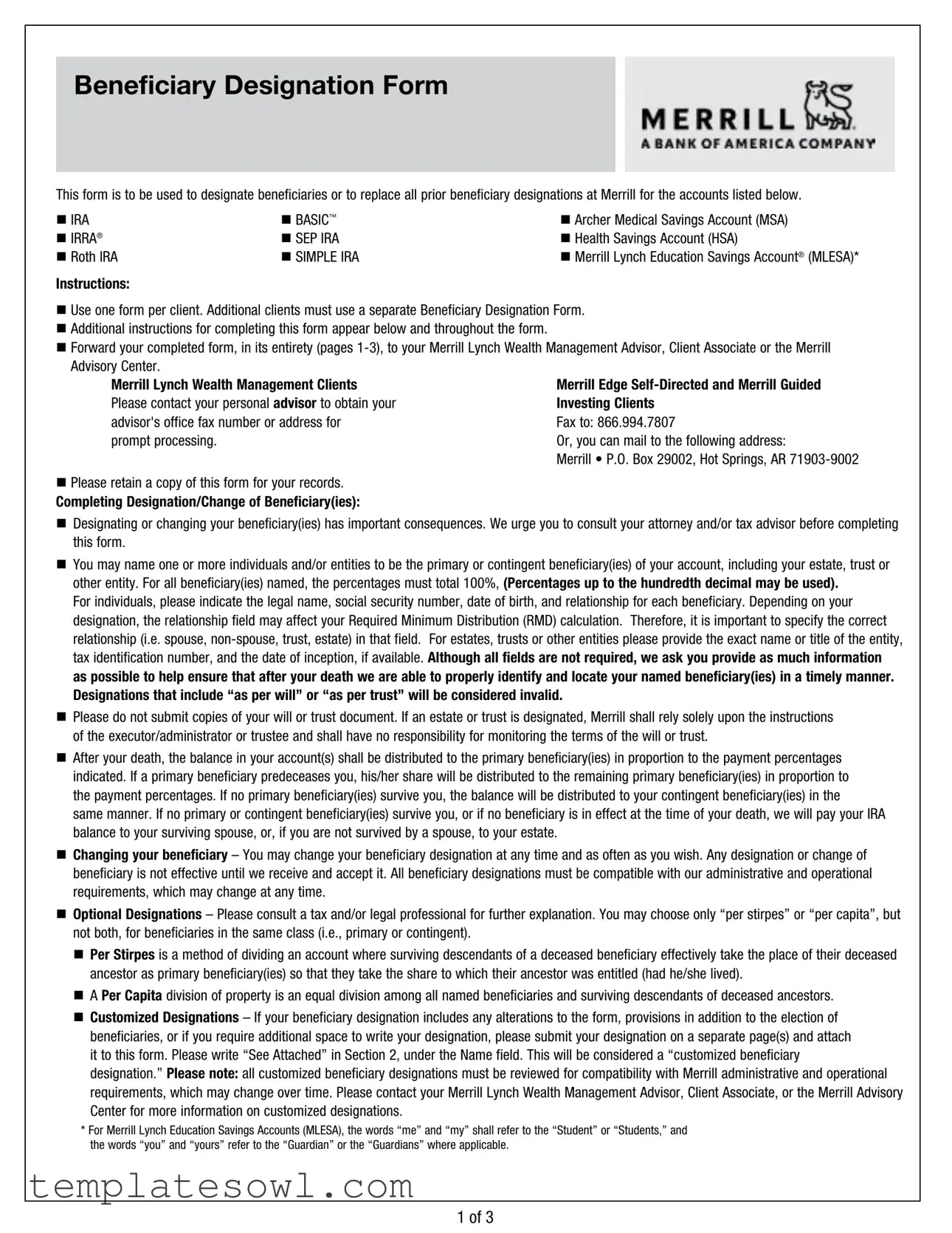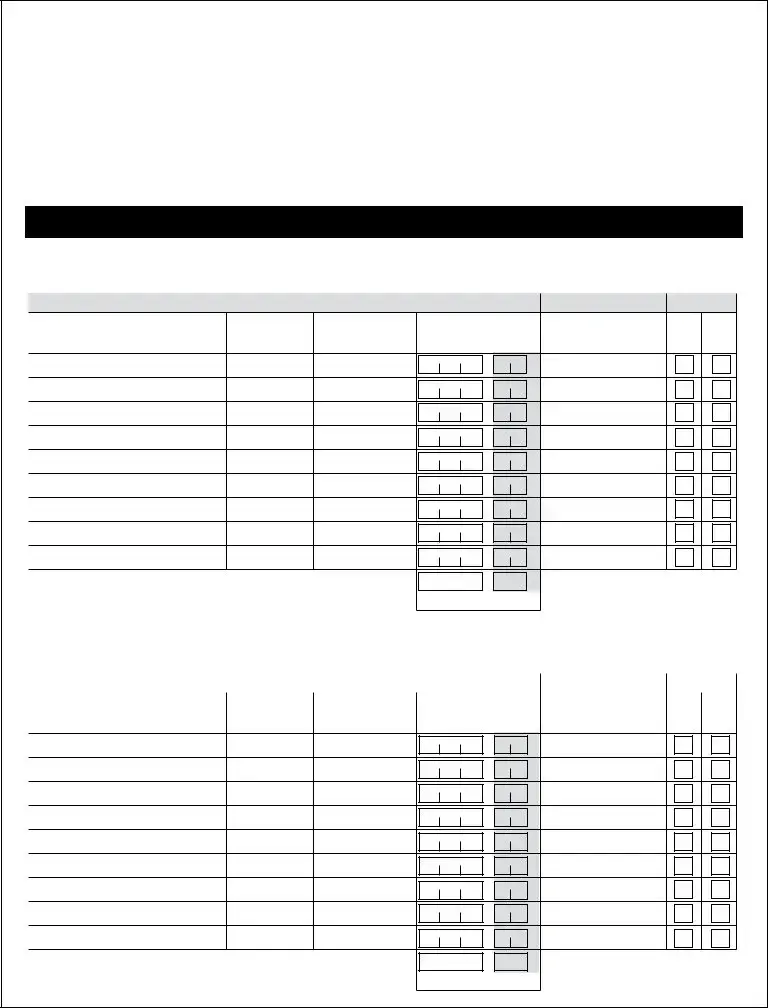Beneficiary Designation Form
MERRILL~.
A BANIK OF AMIUl'ICA C:OMPAN"I'
This form is to be used to designate beneficiaries or to replace all prior beneficiary designations at Merrill for the accounts listed below.
n IRA |
n BASIC™ |
n Archer Medical Savings Account (MSA) |
n IRRA® |
n SEP IRA |
n Health Savings Account (HSA) |
n Roth IRA |
n SIMPLE IRA |
n Merrill Lynch Education Savings Account® (MLESA)* |
Instructions:
nUse one form per client. Additional clients must use a separate Beneficiary Designation Form.
nAdditional instructions for completing this form appear below and throughout the form.
nForward your completed form, in its entirety (pages 1-3), to your Merrill Lynch Wealth Management Advisor, Client Associate or the Merrill
Advisory Center. |
|
Merrill Lynch Wealth Management Clients |
Merrill Edge Self-Directed and Merrill Guided |
Please contact your personal advisor to obtain your |
Investing Clients |
advisor's office fax number or address for |
Fax to: 866.994.7807 |
prompt processing. |
Or, you can mail to the following address: |
|
Merrill • P.O. Box 29002, Hot Springs, AR 71903-9002 |
nPlease retain a copy of this form for your records.
Completing Designation/Change of Beneficiary(ies):
nDesignating or changing your beneficiary(ies) has important consequences. We urge you to consult your attorney and/or tax advisor before completing this form.
nYou may name one or more individuals and/or entities to be the primary or contingent beneficiary(ies) of your account, including your estate, trust or other entity. For all beneficiary(ies) named, the percentages must total 100%, (Percentages up to the hundredth decimal may be used).
For individuals, please indicate the legal name, social security number, date of birth, and relationship for each beneficiary. Depending on your designation, the relationship field may affect your Required Minimum Distribution (RMD) calculation. Therefore, it is important to specify the correct relationship (i.e. spouse, non-spouse, trust, estate) in that field. For estates, trusts or other entities please provide the exact name or title of the entity, tax identification number, and the date of inception, if available. Although all fields are not required, we ask you provide as much information as possible to help ensure that after your death we are able to properly identify and locate your named beneficiary(ies) in a timely manner. Designations that include “as per will” or “as per trust” will be considered invalid.
nPlease do not submit copies of your will or trust document. If an estate or trust is designated, Merrill shall rely solely upon the instructions of the executor/administrator or trustee and shall have no responsibility for monitoring the terms of the will or trust.
nAfter your death, the balance in your account(s) shall be distributed to the primary beneficiary(ies) in proportion to the payment percentages indicated. If a primary beneficiary predeceases you, his/her share will be distributed to the remaining primary beneficiary(ies) in proportion to the payment percentages. If no primary beneficiary(ies) survive you, the balance will be distributed to your contingent beneficiary(ies) in the same manner. If no primary or contingent beneficiary(ies) survive you, or if no beneficiary is in effect at the time of your death, we will pay your IRA balance to your surviving spouse, or, if you are not survived by a spouse, to your estate.
nChanging your beneficiary – You may change your beneficiary designation at any time and as often as you wish. Any designation or change of beneficiary is not effective until we receive and accept it. All beneficiary designations must be compatible with our administrative and operational requirements, which may change at any time.
nOptional Designations – Please consult a tax and/or legal professional for further explanation. You may choose only “per stirpes” or “per capita”, but not both, for beneficiaries in the same class (i.e., primary or contingent).
n Per Stirpes is a method of dividing an account where surviving descendants of a deceased beneficiary effectively take the place of their deceased ancestor as primary beneficiary(ies) so that they take the share to which their ancestor was entitled (had he/she lived).
n A Per Capita division of property is an equal division among all named beneficiaries and surviving descendants of deceased ancestors.
n Customized Designations – If your beneficiary designation includes any alterations to the form, provisions in addition to the election of beneficiaries, or if you require additional space to write your designation, please submit your designation on a separate page(s) and attach it to this form. Please write “See Attached” in Section 2, under the Name field. This will be considered a “customized beneficiary designation.” Please note: all customized beneficiary designations must be reviewed for compatibility with Merrill administrative and operational requirements, which may change over time. Please contact your Merrill Lynch Wealth Management Advisor, Client Associate, or the Merrill Advisory Center for more information on customized designations.
*For Merrill Lynch Education Savings Accounts (MLESA), the words “me” and “my” shall refer to the “Student” or “Students,” and the words “you” and “yours” refer to the “Guardian” or the “Guardians” where applicable.



